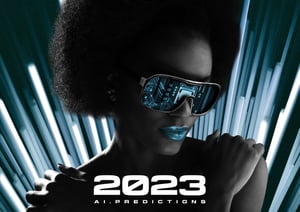Amsterdam, December 2022 - The developments in the field of Artificial Intelligence (AI) are following each other in rapid succession. Because AI can be applied in virtually all domains and sectors, its social and economic potential is enormous. No wonder we started investing even more in AI-based solutions last year. In addition, we again saw many new developments and speculations about how AI is going to change the future. But what can we expect from this technology in the new year? BrainCreators, the specialist in digital inspection based on AI technology, makes five AI predictions for 2023.
The five AI predictions for 2023
1 Foundation models on the rise
One trend we are hearing more and more about is "the democratization of AI. Democratization of AI means that AI technologies are becoming more accessible and easier to develop. In 2023, we will see increasingly better tools for non-specialists to build their own products. In particular, this will come from better user interfaces.
In addition, another form of democratization is the availability of foundation models. These are models that have been trained in advance on very large data sets, often by large players in the ICT field. Such models make it possible for smaller parties to quickly develop an AI prototype without having to collect and clean-up data and train an AI model themselves. However, this will increase their dependency on the AI models and these new capabilities, as it will be challenging for smaller parties to see the training data, understand the bias or discover what effect it has on the target audience.
2 Text-to-image generation models
The most famous, sensational breakthrough of AI in 2022 was text-to-image AI generation models, such as DALL-E, Stable Diffusion, and Imagen. Text-to-image AI creates a new image from many images based on pre-entered text. This is possible because the algorithms of text-to-image AI are trained on large datasets of images found on the Internet. Consider the volume of publicly available images that can be found on the Internet through image databases for example. The realism of the images and the ease of developing variations on a theme purely from text prompts took this technique to a new level. Additional features were also impressive, such as the inpainting feature, which allowed people to look around the room of "the girl with the pearl earring" (Vermeer's world-famous painting).
In 2023, text-to-image AI is undoubtedly going to continue. Not only will the generated images get better and better, but especially the new applications in the fields of design and art will also start to take serious shape in 2023. It is conceivable that after 2023 every graphic designer will have access to text-to-image AI.
3 Smarter language processing
Language models will also get a little smarter in 2023. A language model is a neural network that is trained to predict the next word based on a sequence of words. In addition, it can perform more language tasks, such as summarizing, translating, and classifying.
Thanks to these advances, Natural Language Generation (NLG), AI that generates natural language from structured data, will become increasingly popular and make text development a lot easier. On the other hand, these improvements will also create challenges. Imagine fake news articles that are even more difficult to detect or students committing fraud by writing their thesis with language generation tools. It will become important, therefore, to make quick choices about where NLG may or may not be applied.
4 More robots
Robots will become more and more visible. By automating tedious repetitive work with robotics, more people can be better applied to work that is more meaningful for them and which requires their human skills and decision-making abilities. By 2023, more and more organizations will see the benefits of this, such as better utilization of scarce specialist human skills in the market. As a result, increased investment in this area will mean that robots will become more specialized and robust, as well as enabling closer direct interaction with humans. Partly this is due to advances in AI. Partly, perhaps, because of a better understanding by designers of how best to deal with AI's limitations.
5 The hype of AI is fading
By 2023, staff and talent shortages will only increase. Organizations will therefore increasingly invest in new technology to address the skills shortage. As a result, organizations will increasingly understand how best to use AI by discovering where the real power of AI lies in supporting human intelligence. As a result, the hype of previous years, that humans would be replaced by AI, will slowly fade away.
"Given the talent, shortage is unlikely to be resolved even in 2023, organizations will look for alternatives to work smarter. Intelligent automation will gain further momentum as a result. Think for example of machines performing human actions or digital inspectors checking roads," said Maarten Stol, Chief Scientist at BrainCreators. "While this will bring benefits to organizations, such a transition will also create the necessary pressure for transparency and accountability. It is therefore important that organizations properly explain to employees how AI technology is being applied. Often, employees do not always realize what AI entails and this can hinder innovation and responsible development of AI within the company."

